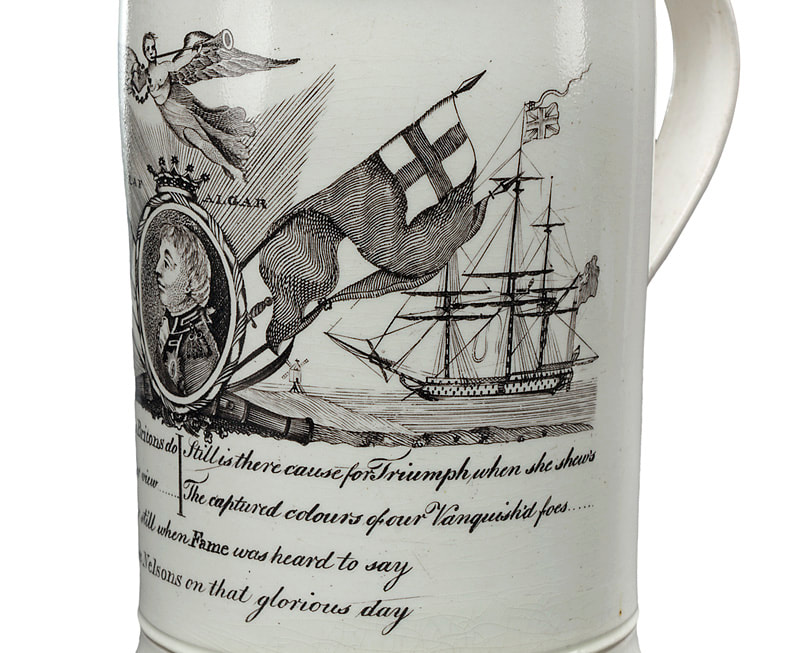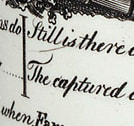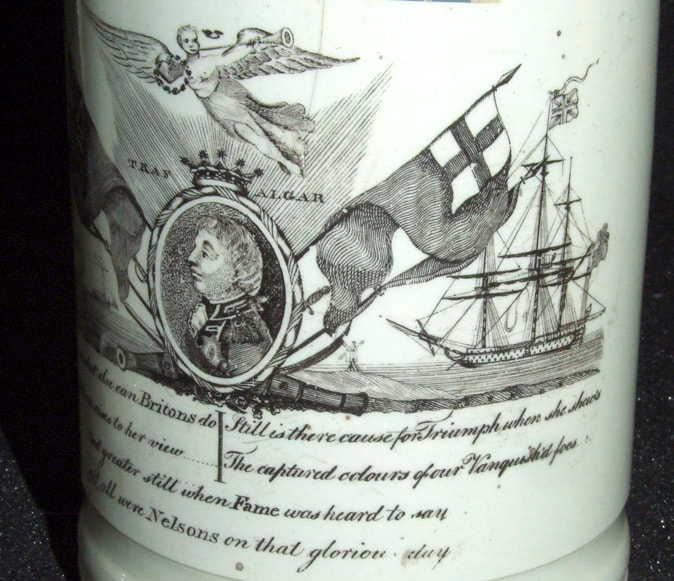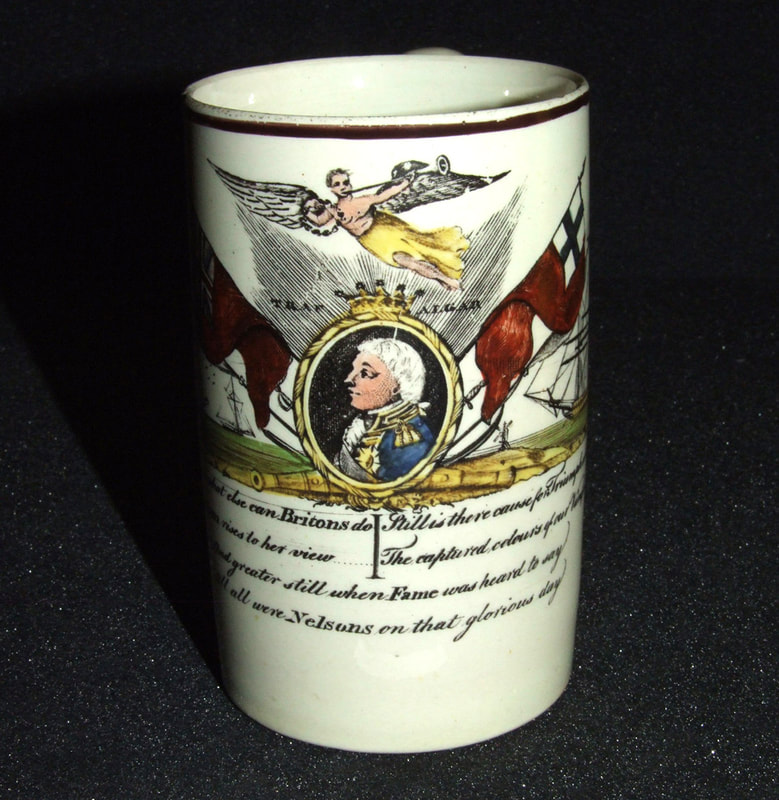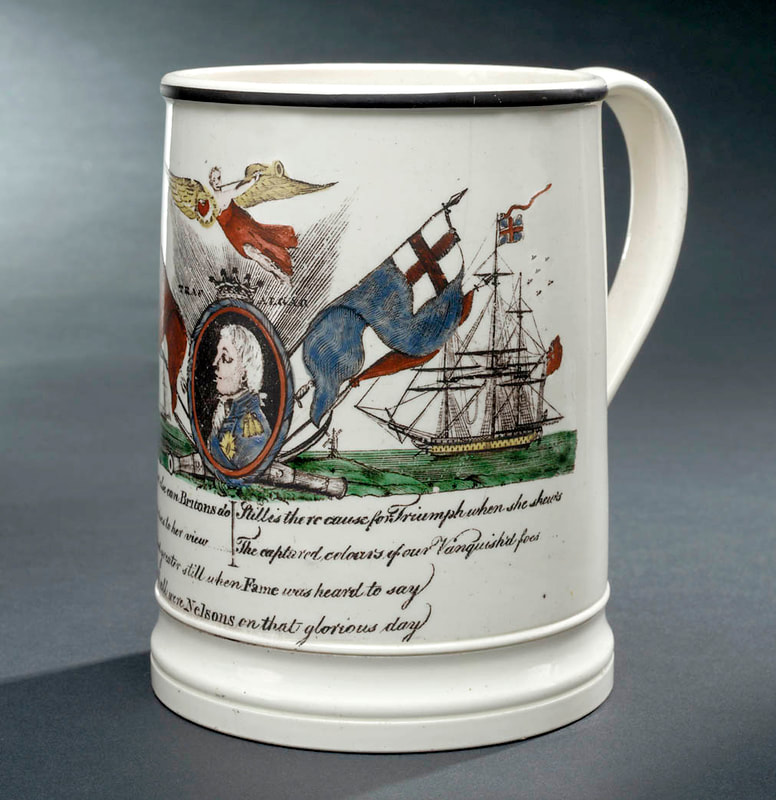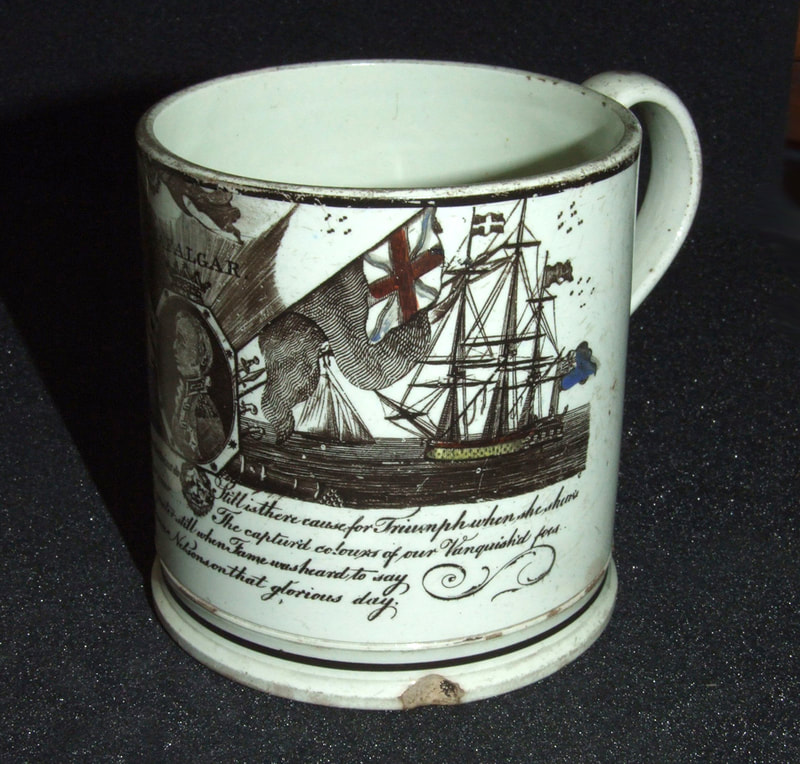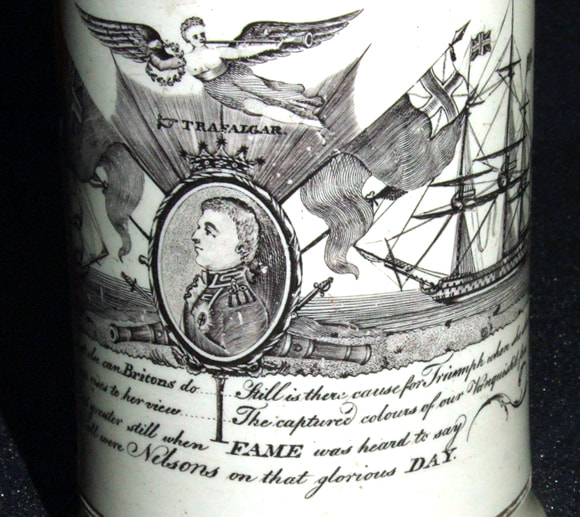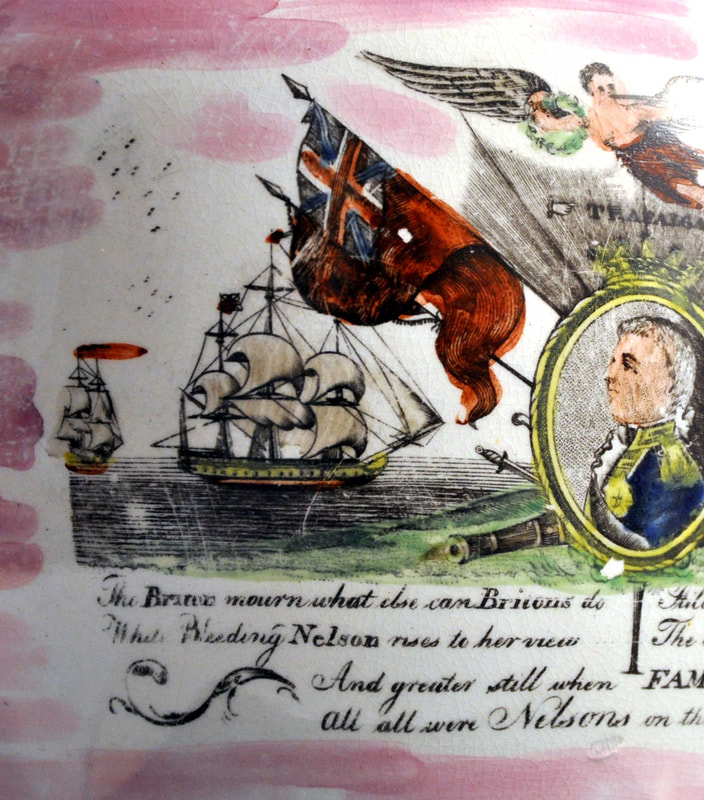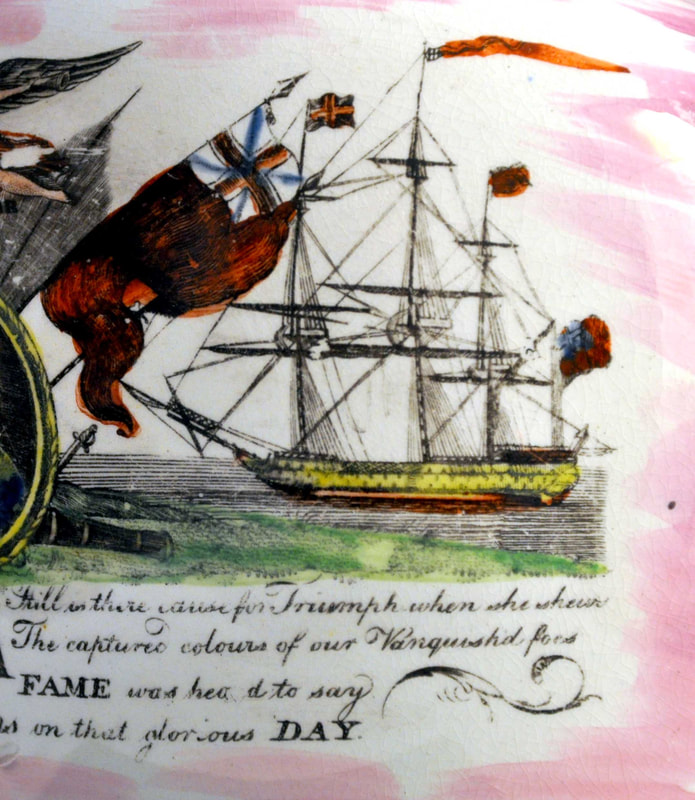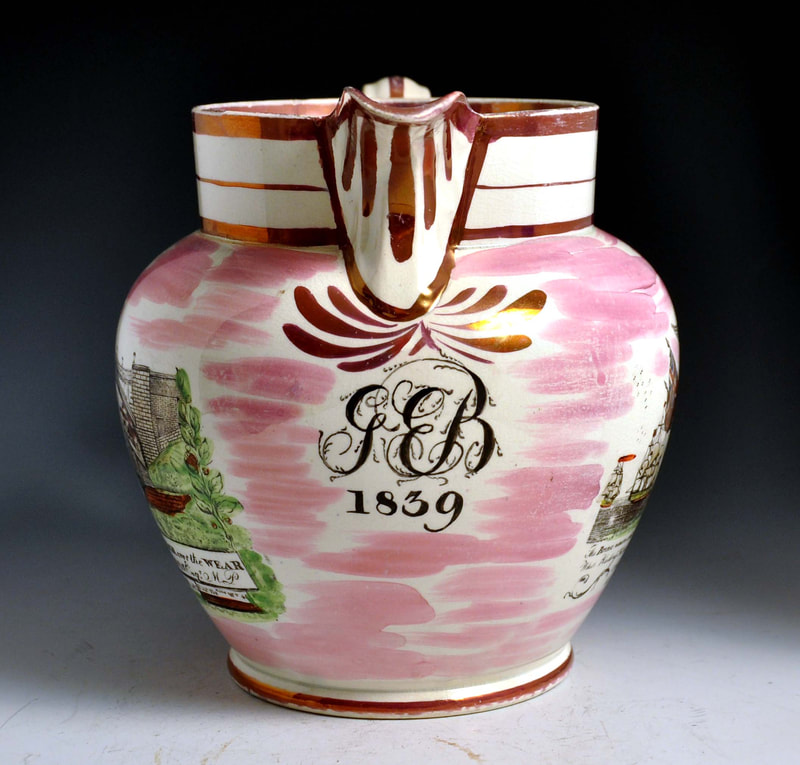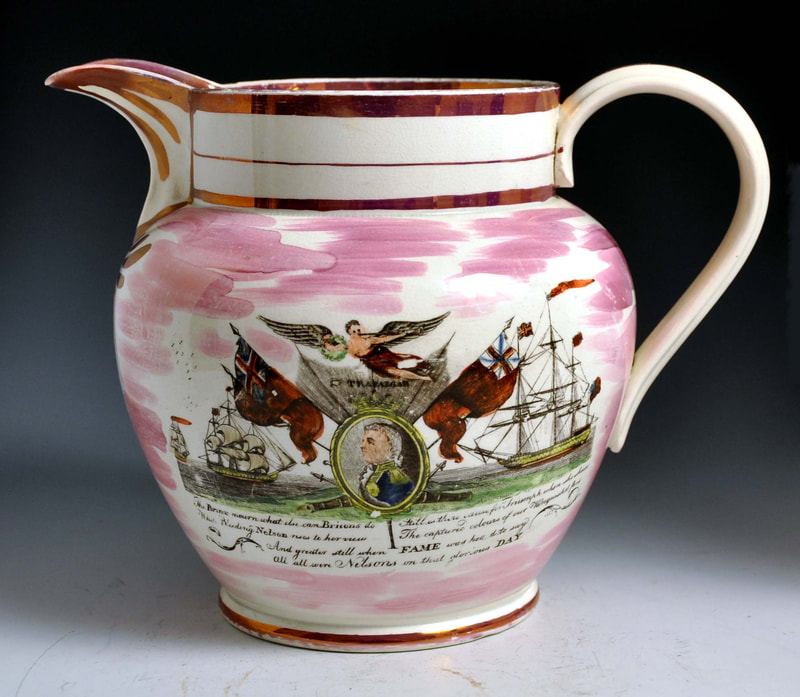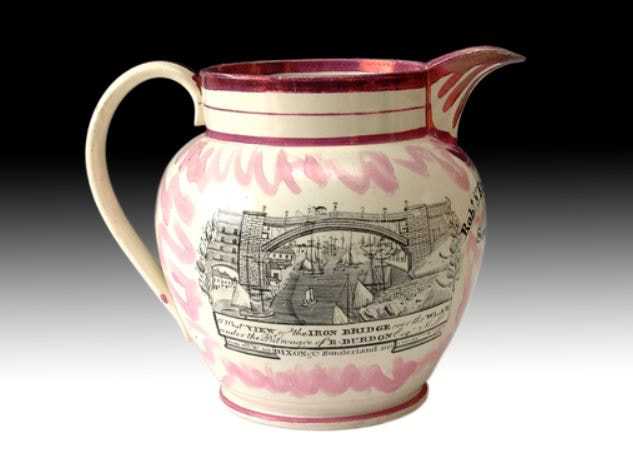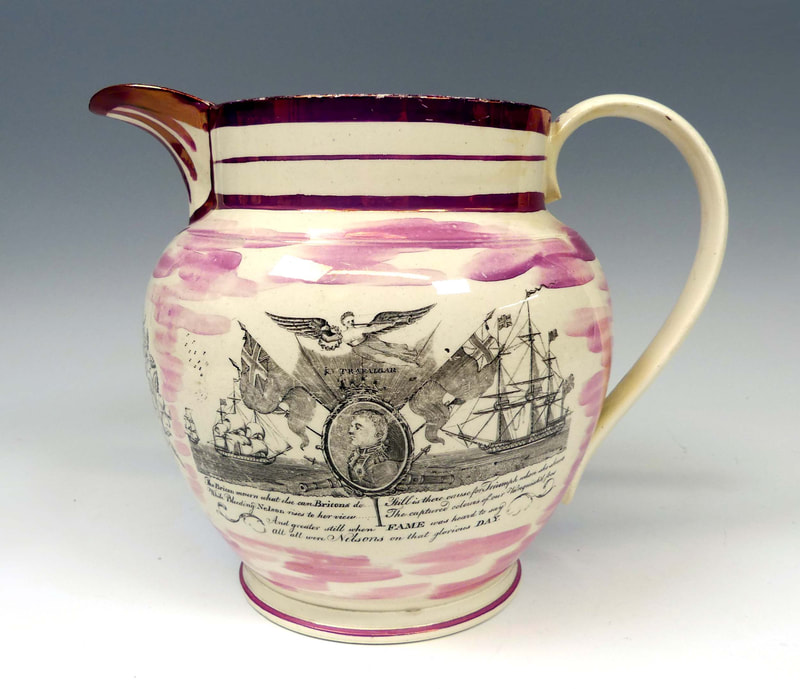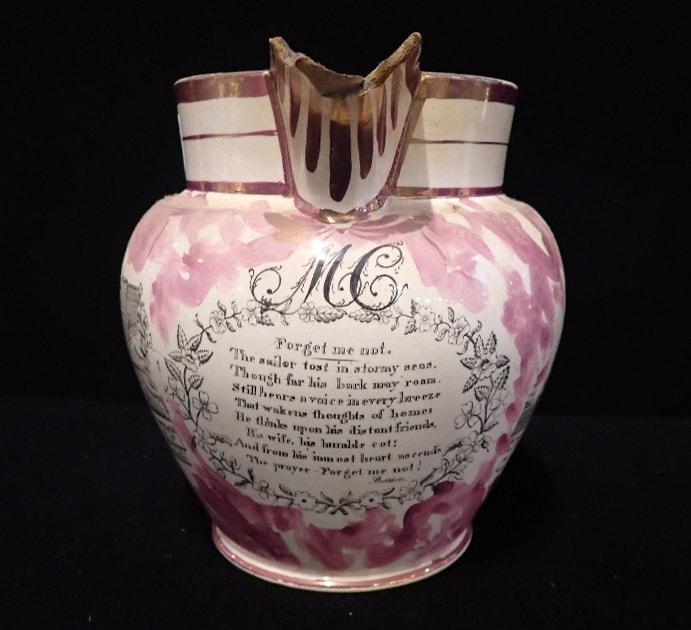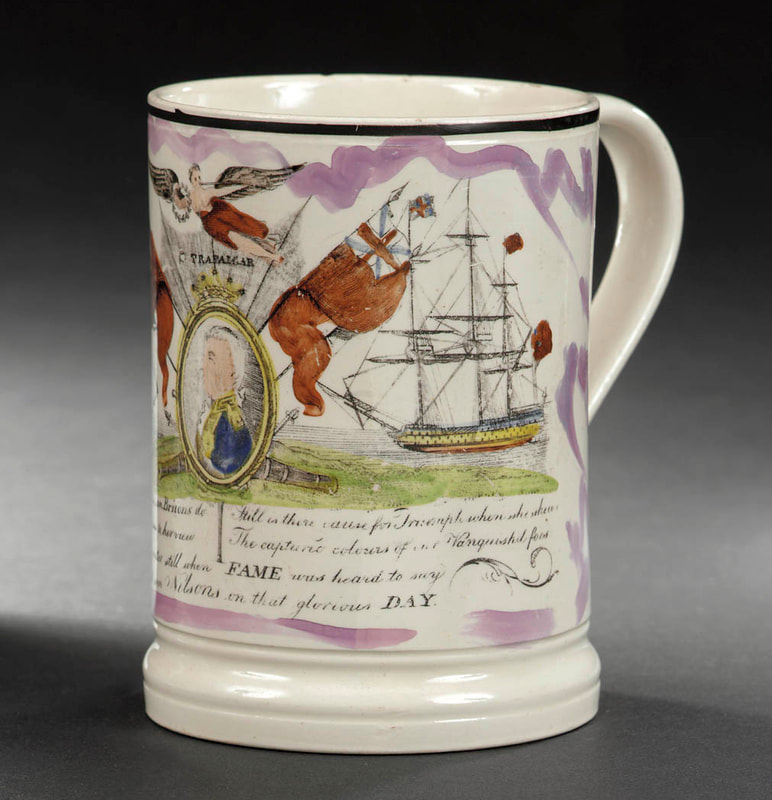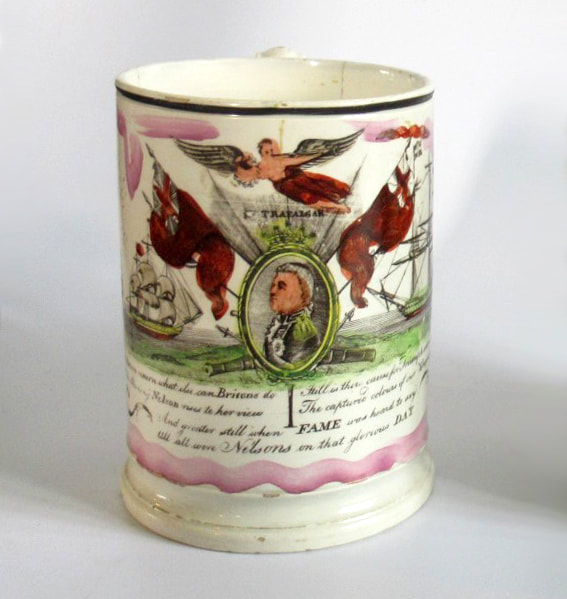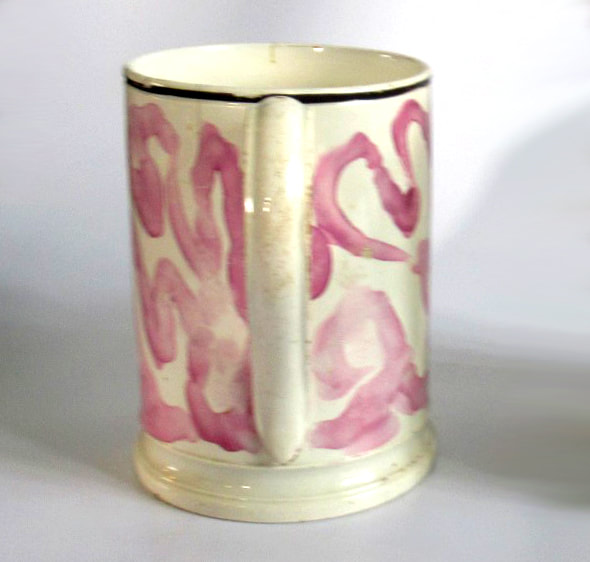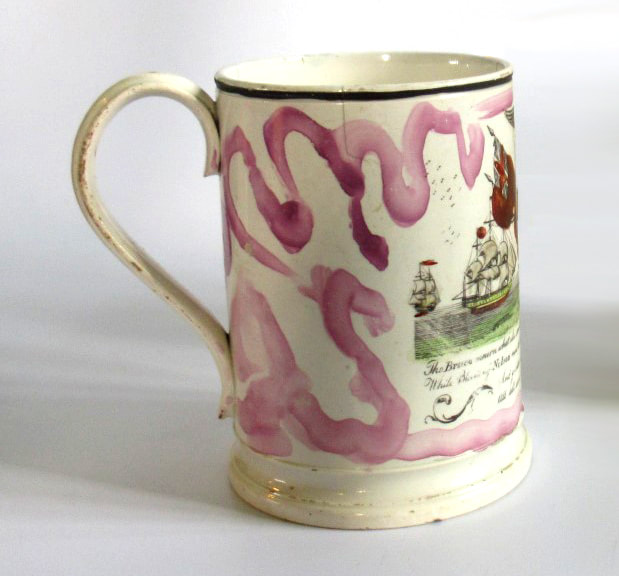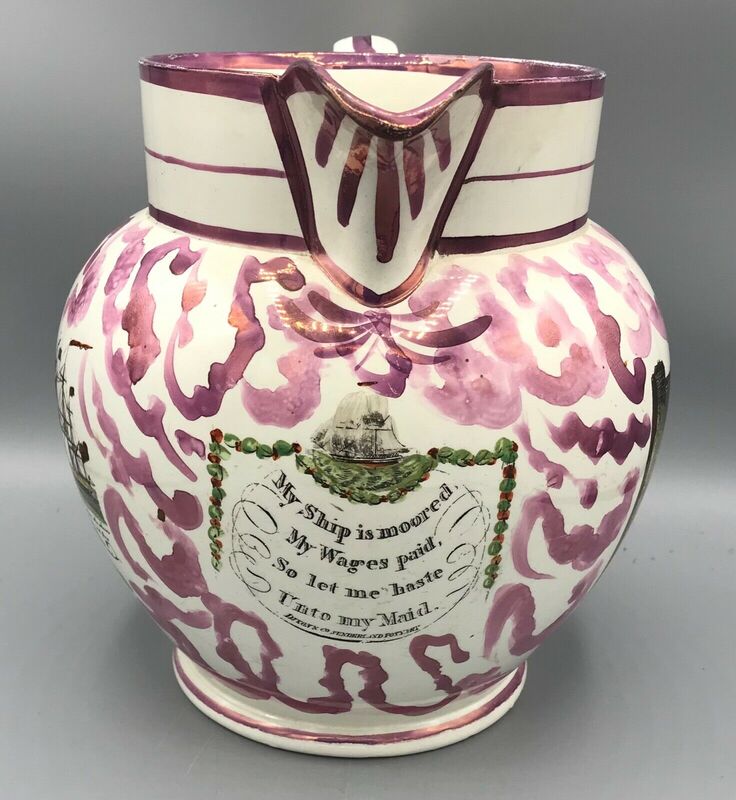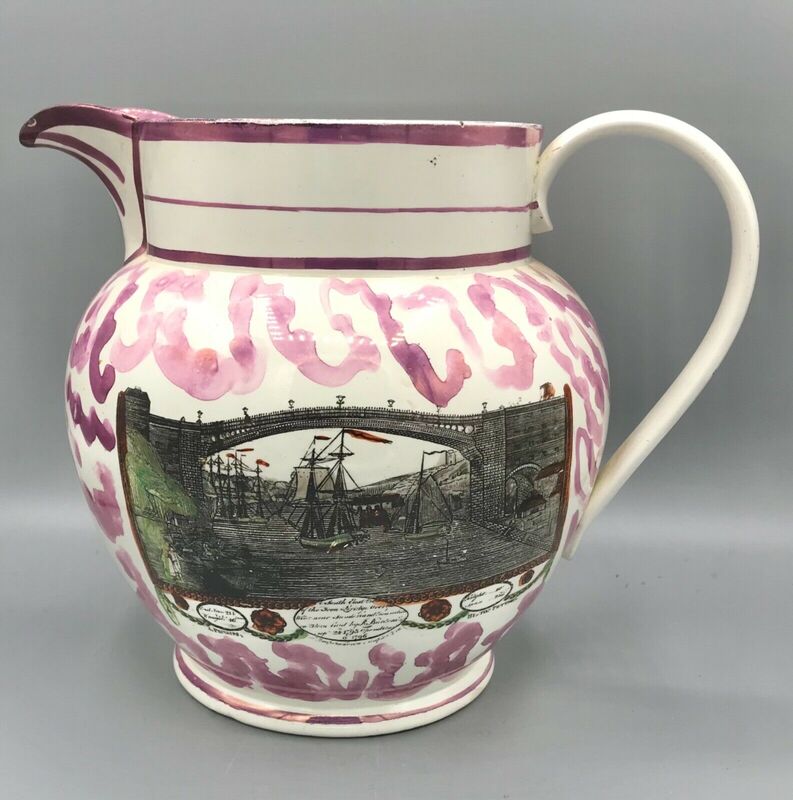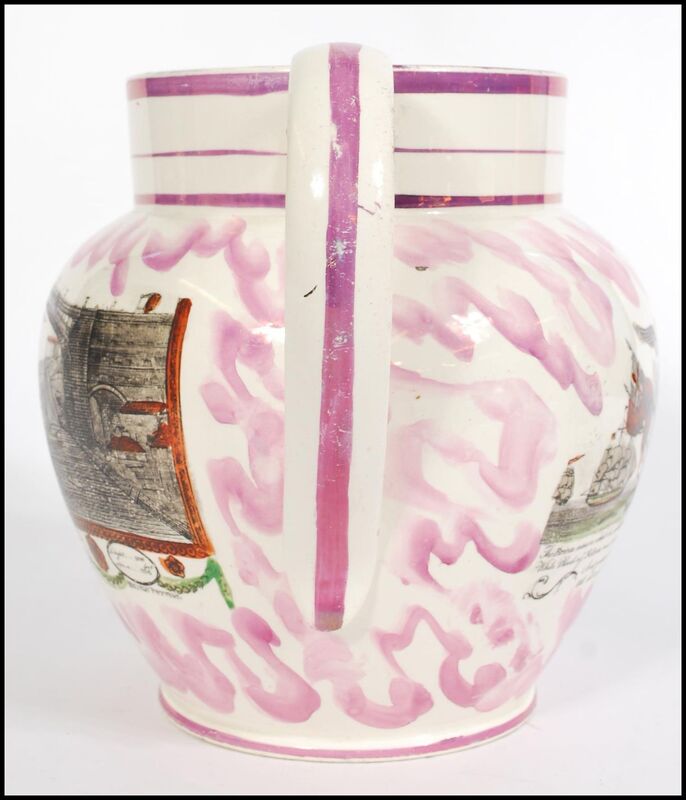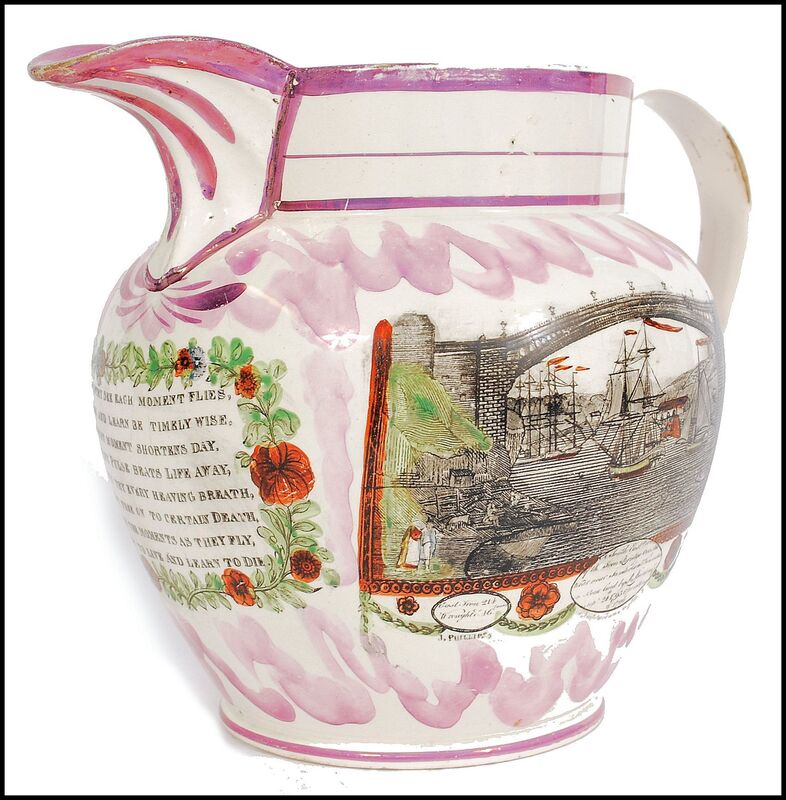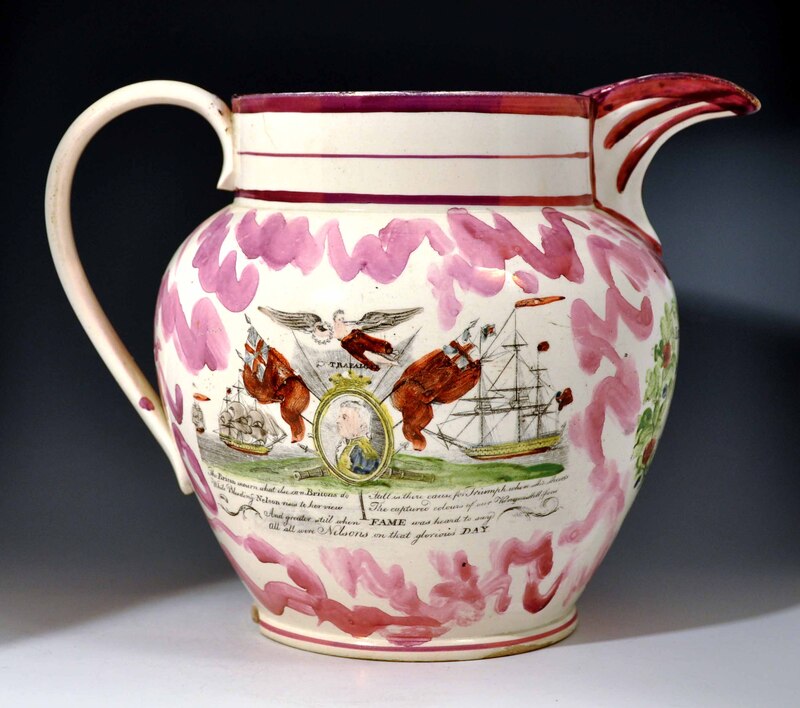Trafalgar
|
The Briton mourns what else can Britons do
While bleeding Nelson rises to her view.... |
Still is there cause for Triumph when she shews
The captured colours of our Vanquished foes |
And greater still when Fame was heard to say
All all was Nelsons on the glorious day
All all was Nelsons on the glorious day
Attributed to Dawson's Low Ford Pottery
On these early items, there are no birds flying to the right of the ship on the right. Note that in this version, the word 'Trafalgar' is split in two above the portrait of Nelson. Below, two mugs from the from the National Maritime Museum, Greenwich, London AAA4923 and AAA4938.
On later (?) imprints there's a scratch on the copper plate under the word 'Still'. These mugs are again from the National Maritime Museum, Greenwich, London AAA4920 and AAA4928.
The first mug below has a Portchester inscription. Norman Lowe has identified a John Wheeler who married Martha Blatch in Hampshire on 30 May 1809. Note the similarity of script with the Dawson-attributed mug beside it (centre). Interestingly, the Trafalgar transfer has also been recorded on the reverse of an ovoid jug with a Portchester inscription and a Dawson bridge view (below right). Unfortunately, I don't have an image of the other side. The auction description says: 'A LARGE CREAMWARE 'NELSONIA' DOCUMENTARY JUG, c1805, the body printed with a view of The Iron Bridge, Sunderland, also with a portrait of Nelson below flags, Trafalgar and motto painted name Richard Whiteing'.
Attributed to Dawson's Low Ford Pottery
The items below are likely from the same copper plate as the items above, but after reengraving. Or perhaps just a near copy. Note the exaggerated uplift of the letter 'y' at the end of the last two lines of the verse, and there are now birds to the right of the ship.
The mug above and ovoid jug below are from the National Maritime Museum, Greenwich, London, AAA4939 and AAA4922. The black feathering decoration around the spout is a feature I hadn't seen on NE pottery previously.
The mug below has a more faded imprint and is perhaps later. The jug beneath it is also faded. At first I thought it was from a different transfer plate. Note the black vertical line under Nelson's portrait cuts through the text. However, I think this is a wrinkle in the transfer, rectified by hand-painting in the text. The last image below is again from a mug in the National Maritime Museum, Greenwich, London AAA4921.
Unidentified Sunderland Pottery
There are only side shots available of these two mugs in the National Maritime Museum, Greenwich, London. Note the scroll design to the right of the text, which is similar to the Sunderland Pottery transfer below, but note that the scroll is reversed. The first AAA4925 you can see the word Trafalgar is not split in two. Also, that there is a shield rather than a black dividing line under the portrait. The second, AAA4929, is a canary yellow example, apparently from the same transfer plate.
The mug below, also from the National Maritime Museum, Greenwich, London AAA4924, appears to have a faint (although perhaps earlier) imprint from the same copper plate. Note the canon are unshaded in this imprint.
Attributed to J Phillips & Co, Sunderland Pottery
This is an early imprint from a copper plate that would continue to be used on pink-lustre items into the late 1830s. Note the word Trafalgar is unbroken, and there are scrolls on either side of the text. The mug below is from the National Maritime Museum, Greenwich, London AAA4927.
Dixon, Austin & Co, Garrison Pottery
This jug has an inscription dated 1839, and shows how long the Phillips version of the Trafalgar transfer was in use.
These jugs with undecorated transfers tend to be from the mid to late 1820s. The first, from the Sunderland Museum & Winter Gardens, Tyne & Wear Archives & Museums collection, has a marriage inscription for 'Scarbro' (Scarborough).
A creamware mug hand-coloured with enamels. The mug below is from the National Maritime Museum, Greenwich, London AAA5160. These items are hard to date and were likely made in both the 1820s and 30s.
The lustre decoration on the mug below is very similar to the jugs beneath it from the 1830s.
Below, three jugs with coloured enamels over the transfers, likely from the 1830s. Interestingly, these jugs have the bridge 3 view with the printed mark 'J Phillips' and 'Hylton Pottery'. However, on the first jug below, that transfer appears in conjunction with a transfer marked 'Dixon & Co'. See the bridge 3 view page for the 'Hylton Pottery' transfer on a similar large jug with an inscription for 1836 and, therefore, made at the end of the Dixon, Austin & Co partnership (1818–1839). It is likely that, given the similarity of decoration to other Sunderland Pottery items from this period, these jugs were produced at the Garrison Pottery site. However, according to Baker, North Hylton was still operating at a reduced scale in 1841, with 26 people recorded in the census that year as working in the potting industry.




